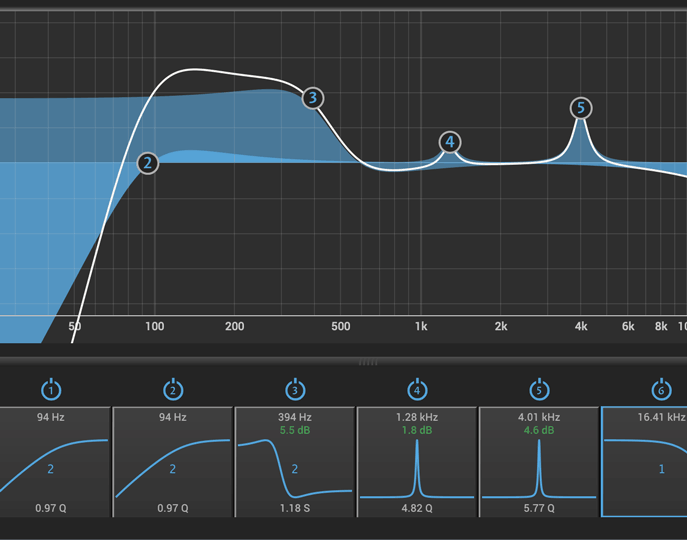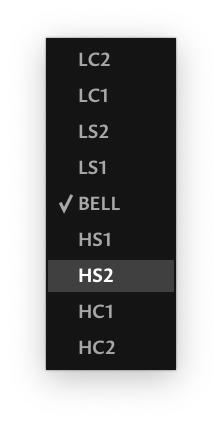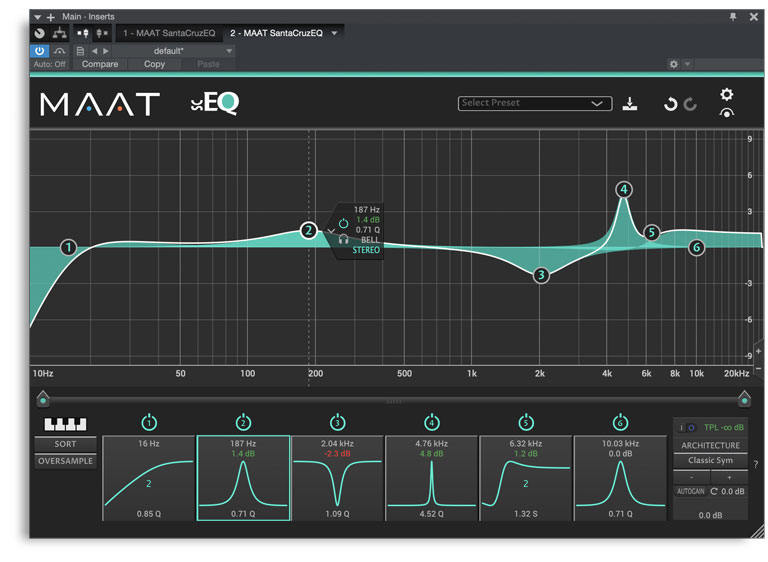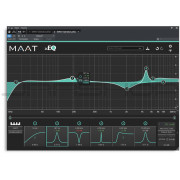You're currently on:
SantaCruzEQ
Lightweight Multi–Architecture MP Equalizer
Six or twelve precision variations on “analog,” all in one affordable EQ.

Yes, Your Blueness
Why develop yet one more minimum phase parametric equalizer (MP PEQ) when there’s already hundreds on the market? The answer is simple…’Cuz there was room for improvement! It was customers of the original LinearPhase PEQ Red and Orange who asked Algorithmix to develop a classic EQ, for recording and mixing tasks, with unparalleled purity and transparency. Over several years, our Dr. Christoph closely analyzed many of the best out there, and compiled a vast knowledgebase of analog EQ best practices. Cherry picking from that, he implemented not just one or two, but an entire collection of trad minimal phase EQs. The result? A distillation of analog antecedents, while others are based on new ideas. We know you’ll enjoy our dozen variations of blue, newly revised by MAAT, and find your favorite sound.
The Not So Dirty Dozen
We wanted to lift analog to another level, so we reverse engineered a variety of well respected hardware EQs, creating idealized digital versions from that inspiration. Rather than models or simulations that carry analog baggage, SantaCruzEQ has no noise, distortion or other secondary effects inherited from analog.
SantaCruzEQ12 is a complete collection of classic equalizer Architectures, assembled into one package. You get precise, idealized examples of legendary analog equalizer circuitry, complemented by progressive new models. Whether it’s vintage, modern, or experimental, SantaCruzEQ is a sonic sandbox for every mixing and mastering engineer to mess around in.
BFF
The equalizer is perhaps the oldest and the most popular of sound processing tools. From its earliest days, the main function was correction or enhancement by boosting or cutting certain frequencies.
For a century, engineers have developed countless equalizers. A few became legend, our thEQorange is one. The most popular version in recording and post is the parametric equalizer or PEQ, first perfected by Massenburg in 1972. It offers maximum flexibility with only three controls. Properly used, the PEQ is a powerful tool and the best friend of every audio engineer in the quest for perfect sound. As Spidey (and Voltaire) always reminds us though, “With great power comes great responsibility.” When designed by a clueless or cost–constrained software engineer, it can be your greatest sonic enemy.
Choice Is Good
SantaCruzEQ is the low CPU version of thEQblue, with six utilitarian Sections. In order to give you a choice of features and price, SantaCruzEQ is available in two versions:
- SantaCruzEQ6, with 6 Architectures; №s 1 through 6 below
- SantaCruzEQ12, with 12 Architectures; all twelve below
| № | Type | Comments & Analog Kinfolk | |
|---|---|---|---|
| 01 |  | Classic Sym | Series symmetrical, almost constant Q bell — common mix desk & outboard gear Architecture, try on “surgical” applications |
| 02 |  | Classic Asym | Series asymmetrical — Old Skool, boost like № 1 but with narrower cut |
| 03 |  | Proportional 1 | Series proportional — More musical than constant Q, especially for mixing and post. Bells are wider at <6dB and narrower at >6dB |
| 04 |  | Proportional 2 | Series proportional — Like № 3 but with bigger changes at large gain settings > ±6dB, try on vocals |
| 05 |  | Proportional 3 | Series proportional — Like № 3 but with extra wide bells at small gain settings, from 0 to 3dB |
| 06 |  | Const-Q Asym | Series asymmetrical, constant Q — Boost like № 1, cut like № 5 (extra wide), as found in some USA products & mixers |
| 07 |  | Const-Q Asy R | Series asymmetrical, constant Q — Like № 6 but with mirrored boost & cut |
| 08 |  | Const-Q Invers | Series symmetrical, constant Q — Similar to № 7 |
| 09 |  | Const-Q New | Series proportional, constant Q — Our special Architecture…try it! |
| 10 |  | Const-Q Ideal | Series ideal & constant Q — Another special, similar to № 1, all three parameters (resonant ƒ, gain & Q) are independent, no analog relatives! |
| 11 |  | Parallel FF-FB | Parallel feed forward/feedback — Complementary amplitude and phase characteristics for boost & cut (symmetrical), found in high end graphic EQs, 1st choice for mastering [reference Massenburg] |
| 12 |  | Parallel LC | Parallel passive LC — Tonal advantages with band interaction & asymmetry disadvantages, found in old or newly recreated PEQs, another choice for mastering [reference Massive Passive, Sontec] |
Constant Q is more for surgical applications, while proportional EQs are best when combining multiple overlapping Sections. As a point of reference, API, Pultec, Masselec and Avalon EQs are all of the proportional type.
☞ Note that all 12 Architectures are normalized to have exactly the same bell shape at 6dB of boost. This allows you to easily compare the sound of each Architecture.

Better By Design
SantaCruzEQ is built on the belief that exceptional fidelity, enhanced workflows and less visual fatigue are hallmarks of better quality toolsets. Our reliance on hard science and focused research balanced by in–depth listening and customer feedback, redefines audio tools for you and your fellow hardcore media professionals worldwide.
Iron Maiden
The contribution of distortion to the specific sound of a particular analog equalizer caused by its respective electronics is largely what makes it “good.” Usually though, non–linear distortion, horrific group delay and other deficiencies produce more “nasty” than “magic.” Our philosophy, for PEQ design, has always been to make filters as precise and clean as possible. For controlled distortion, we recommend high quality tape emulation, a well made pedal or other carefully applied studio magic.
Comprehensive
With SantaCruzEQ, you can call up to six Sections from one of the six (SantaCruzEQ6) or twelve (SantaCruzEQ12) architectural styles available. For the first and last Sections, choose from a selection of shelving or cut filters. For the four (SCEQ6) or ten (SCEQ12) center Sections, choose from nine freely assignable filter topologies, including bell, first and second order low or high shelf along with first and second order low or high cut.
The most significant filter types bearing the equalizer name are bells or peaking filters. Set to a particular Q, different bells change their bandwidth depending on the amount of boost or cut making comparison difficult between Architectures. But wait, we’ve made it easy…
Comparing Architectures…
In order to make meaningful comparisons of different styles, all twelve equalizer Architectures are normalized to have exactly the same bell shape for +6dB of gain. If you listen to a bell filter at +6.02dB and a Q of 0.71, you will get the same audible result for all Architecture types. This normalization of the Q or Quality Factor is a unique MAAT feature, and distinguishes our Architectures from their analog antecedents because many of the originals have undefined Q definitions due to the limitation of analog technology. The normalization allows you to compare the different EQ Architectures in SantaCruzEQ with ease.
BTW, a single minimal phase bell filter with identical shape will sound the same regardless of Architecture. The difference between Architecture becomes obvious when you have activated more bells and other topologies so that they start to interact with each other. This will reveal the different characteristics of each Architecture, in terms of phase interaction and different gain and Q relationships.

Classics All
The Classic Symmetrical is the most popular bell shape used in many mixers and outboard equalizers. It is almost “constant Q.” That is, as resonant frequency changes, the bandwidth changes, widening as the frequency goes from low to high to maintain a constant ratio of center frequency divided by bandwidth. Constant Q is roughly the way our hearing perceives an EQ’s effect.
The three Proportional PEQs emulate bell characteristics which change their bandwidth proportional to their boost or cut. Many think they behave more musically as you don’t have to correct the Q after every amplitude change. There are also three other constant–Q equalizers available, with characteristics similar to some classic American brands.
SantaCruzEQ also offers two proprietary constant–Q varieties. The first, Constant-Q Ideal, is a perfect version of the Classic Symmetrical equalizer, having exactly the same bandwidth at any amplitude within its range of Q. This is measured 3 dB below maximum amplitude at and above +6 dB of boost. Such PEQs are impossible to implement in the analog domain, hence the “ideal” name. Another specialty variety is the Constant-Q New, which follows a new Q definition. It preserves exactly the same bandwidth at the half of the maximum amplitude for all amplitude values. Unlike the classic Q definition, this includes the range below 6 dB of boost. Due to its amplitude/bandwidth dependency in terms of a classic Q definition, this new kind of constant-Q PEQ could also be thought of as a member of the proportional group.
Finally we emulated two vintage parallel equalizers. With parallel construction, the main input feeds every filter in parallel, with each filter’s output being summed together for the final composite output. With a series implementation, filters are cascaded; each fed from the output of the previous filter. Unlike a series parametric equalizer (almost all paramets are serial), parallel–connected filters combine or cascade differently. They also behave differently in terms of phase. Their special interactive behavior between bands is offset by a pleasing sonic character. Our Parallel LC emulates old skool parallel passive PEQ circuitry built with inductors and capacitors. The Parallel Feed–Forward/Feedback Architecture emulates the feed–forward/feed–back designs still popular in low noise analog graphic EQs. While the feed–forward path is trivial to implement, the feedback path is impossible to implement in traditional digital signal processing, because of the need for so called “delay–free” feedback loops. In SantaCruzEQ, we apply a unique and very elaborate technique for true emulation of delay-free feedback. The result is a characteristic sound and perfectly complementary filters for boost and cut.
The Filter Library
In SantaCruzEQ, not only are various bell–shaped filters available but also different kinds of shelving filters. Nine of the series equalizers use a special shelving design characterized by a cut–off frequency defined in the middle of the transition region. We found these filter definitions more intuitive than the classical “–3 dB below maximum.” The old skool definition is only used in the Classic Asymmetrical Architecture in order to conform to its analog antecedent. All 2nd order shelving filters have a Q adjustment to emulate vintage characteristics, with their inherent and specific bumps at higher slopes. Also, the parallel equalizers are equipped with respective shelving filters shapes that are typical of old parallel PEQs. They also have interacting bands as did their analog predecessors.
Every complex PEQ is equipped with cut filters. With SantaCruzEQ, each of the twelve equalizer Architectures can provide 1st and 2nd order cuts. The 2nd order filters have a Q adjustment to create a resonant filter response, and can be combined to provide very steep “brickwall” slopes by cascading several Sections.
Best of Both Worlds
SantaCruzEQ is a creative equalizer tool combining the best of both the analog and digital domains. To avoid bell filter asymmetry at high frequencies for baseband sample rates, typical of many digital equalizers, we have applied reference–quality upsampling, which automatically kicks in for 44.1 or 48 kHz. By using proprietary filter algorithms, we have achieved a huge dynamic range, as well as extremely low noise and distortion. This yields unparalleled sonic purity, impossible for any analog circuitry. We suggest leaving the oversampling option always on so as to get the “analog” smoothness missing from other brand’s EQs.
MAAT Minimum Phase EQ Plug–Ins
Feature Comparison
| thEQblue6 | thEQblue12 | SantaCruzEQ6 | SantaCruzEQ12 | ||
|---|---|---|---|---|---|
| Features | ⊹ Notes ⊹ | ||||
| Architectures§ | Twelve architectures: №s 1-10, serial type; №s 11-12, parallel type | 6 total; №s 1-6 | 12 total; №s 1-12 | 6 total; №s 1-6 | 12 total; №s 1-12 |
| Sections | Five topologies available: 1st & 2nd order, variable slope cut & shelf; parametric bell | 12 total; all five topologies | 12 total; all five topologies | 6 total; #1 & 6 are cut & shelf only; #2 - 5, all five topologies | 6 total; #1 & 6 are cut & shelf only; #2 - 5, all five topologies |
| Metering | Signal present + wide range & numeric TP | Signal present + wide range & numeric TP | Signal present | Signal present | |
| Panorama Control‡ | Left–only, R–only, mono, stereo, L-R | Yes | Yes | No (stereo–only) | No (stereo–only) |
| Spectrogram | Yes; can be disabled | Yes; can be disabled | No | No | |
| Tuning | Yes; ƒ–snapping | Yes; ƒ–snapping | No | No | |
| Upgrades | Yes; to thEQblue12 for additional cost | No | Yes; to SantaCruzEQ12 for additional cost | No upgrade path to thEQblue |
§ – For more on the architectures incorporated into thEQblue and SantaCruzEQ, see our Understanding EQ Architectures PDF.
‡ – Parallel architectures do not support L-R Panorama mode.
Session Compatibility between SantaCruzEQ12 and SantaCruzEQ6
Session interchange between the two versions can take two forms:
• Scenario A: A colleague uses instances of SantaCruzEQ6 in a DAW session, then sends the session to a colleague with SantaCruzEQ12. — All instances will open and work correctly.
• Scenario B: A colleague uses instances of SantaCruzEQ12 in a DAW session, then sends the session to a colleague with SantaCruzEQ6. — This scenario is only slightly more complicated…If the sender restricts their use to Architectures No. 1 through 6, then all instances will open as saved. If however, the sender uses Architectures No 7-12 in a saved session and sends that to their colleague, it will “snap” to Architecture No. 1 and may/will need to be remapped.
Reviews & Testimonials
Nikos "Rizon" Rizos — producer, mix engineer & loopmeister at RAW LOOPS
“First of all it sounds amazing! I don’t know what exactly is going on behind the scenes but it is superior in every aspect sound wise comparing to other EQ plugins.
It has a certain depth and keeps the signal’s integrity while sounding musical at the same time. Every time I tried to replace an emulation (Manley, Millenia, Neve, Sontec), by far I preferred SantaCruzEQ, sometimes with an extra transformer or preamp emulation after it if needed for some more colouration. But what makes it indispensable is that it retains the quality and characteristics of the material that passes through it. A well recorded, let’s say analog synth or drum machine, after passing through SantaCruzEQ is still a well recorded synth with some EQ on it, not a flat replica of the original.
I…was surprised by the depth and sonic accuracy it retains even with extreme settings. As the music we are involved in consists of deep subs and clean sine wave basses, many EQs fall short and loose depth and transient definition while managing those specific areas. That is not the case with SantaCruzEQ, it just does its job without messing with the signal. It is the first plugin we have heard that does that!”
Alberto Rizzo Schettino, Fundamentals of Mixing || MAAT Digital Core Plug-ins
Schettino has created a comprehensive look at many of our products and how they fit together
Peter “Minimalistix” Bellaert – producer, composer & arranger
“Your SantaCruzEQ and thEQorange kill ProQ and many other EQs!! You’ve got the best EQ I ever heard, really!!”
Thomas Joren Nielsen — composer & engineer
“The high end on SantaCruzEQ is something of the gods. 10x better than oversampling on FabFilter Pro-Q3. And Neutron3 can kiss my ass. I really like having the algorithm (Architecture) options available too. Seriously, most plugins only have two “Digital Q or Analog Q” so this is something that really sets it apart. Will def be implementing this all over my mixes.”
Ali Ramadan — Toronto CA & RAK City UAE
“Your products are boutique…SCEQ is the only EQ I am using beside thEQblue and thEQorange (for mastering). It’s light, easy to use, flexible, effective and ‘analog sounding.’ I am addicted to Classic Asym, Const Q Asym, and parallel FF-FB.”
Arnold “DJ Kodi/Purple Avenue” Toutain
“MAAT SantaCruz EQ : Blown away !
I saw today a promo for SantaCruz EQ so gave it a chance & demoed it. For the moment it's the most incredible EQ that I had the opportunity to work with…
I mostly work in Pro Tools with PSP Neon (transparent), EQuilibrium (Swiss army knife) and stock Eq most of the time. I don't say that I will never ever use these plugins as I think they sound very well. But this thing…never heard such transparency or clarity in an EQ plugin for cleaning a mix or giving some air.
Tested SantaCruz against SSL X-EQ (supposed to be Algorithmix based) with Hofa A/B: I would say that Maat EQ sounds clean in a good way & never alter stereo image (solid sides). the SSL sounded great but changed the "panorama" of the songs.
+ Pros: The sound!
- Cons : No meter, no analyzer & no mid/side processing
…this plugin is simply the purest EQ I had the opportunity to test. I bought it!”
Don Gunn — engineer (Death Cab, Frampton, Soundgarden, King Crimson)
“I purchased RSPhaseShifter and SantaCruzEQ this week and I'm EXTREMELY pleased with my decision; these are truly excellent sounding tools that are already making me question some of my other plugin choices...”
Alex Solano — Alex Pro Mix
Alex does a breakneck run through of SCEQ as part of a “Plugin Ranker” video and, despite erroneous info about Q control via mouse, concludes, “…very impressive.”
Ignacio Ponce — Integraudio
Ignacio’s long form review includes audio example clips. His take: “SCEQ was a very transparent and useful tool…Not only was it effective at balancing and tweaking the different bands, but it also gives you a lot of different options when it comes to EQing according to your needs. If you want a more musical way of cutting or boosting, you have a specific Architecture for that…It's a very good overall plug-in with many capabilities that are at the tip of your fingers.
“What makes this plug-in standout is the Architecture's (feature). You can choose many different sound processing techniques, which will give you different results and be extremely useful for specific cases.”
Features
- Fully parametric minimum phase EQ for complete control
- 80 bit internal precision blows away the competition for sound quality
- Up to twelve unique idealized Architectures, derived from analog circuitry
- Broad choice of cut, shelf and bell topologies
- AutoGain for effortless A/B comparisons
- Proprietary oversampling for “analog” sound at 44.1 and 48k
Supporting
- AAX Native (Pro Tools 10.3.10 and newer), AU, VST 2, VST 3
- Sample rates from 44.1 to 384 kHz
VST
VST PlugIn Interface Technology by Steinberg Media Technologies GmbH
License
- Perpetual: One–Time Buyout…
— SantaCruzEQ6 [Architectures No. 1-6]
— SantaCruzEQ12 [Architectures No. 1-12]
Requirements
- macOS 10.9 and newer, 64 bit only
- Windows 7 and newer, 32 & 64 bit
| Variant | 1 |

















